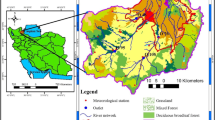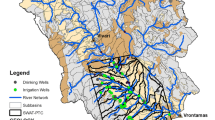Abstract
Assessing the relationship between Surface Water (SW) and Groundwater (GW) is an important aspect of hydrology, as it aids in the conjunctive and effective management of water resources. This study characterized the surface–groundwater interaction in the Modjo River catchment, central Ethiopia using the Soil and Water Assessment Tool (SWAT) and MODFLOW models. The SWAT model adequately simulated the hydrology of the study area for the calibration (2007–2011, R2 = 0.83) and validation (2012–2015, R2 = 0.7) periods. The semi-distributed average GW recharge from the SWAT model simulation with other hydrogeologic parameters and boundary conditions was utilized to construct the GW flow model using the MODFLOW–NWT version. The integrated modeling result showed that about 43Mm3 of water leaks to the groundwater system annually, whereas the flux from GW to rivers is about 165Mm3/yr. Most reaches of the Modjo River in the northern and central areas of the catchment are gaining, with fluxes reaching up to 4940 m3/day. The downstream part of the catchment is characterized by a losing-disconnected river, with a lower flux of up to 675m3/day. In general, most reaches of the Modjo River are interconnected with the GW system and the GW inflow to streams is higher. Based on these findings, future exploitation and management of both SW and GW resources should consider the nature of their interconnection for sustainable utilization of the water resources in the catchment.














Similar content being viewed by others
Data availability
Data will be made available on request.
References
Abbaspour K (2015) SWAT-CUP: SWAT calibration and uncertainty programs—a user manual. Swiss Federal Institute of Aquatic Science and Technology, Duebendorf, pp 1–100
Adeba D, Kansal ML, Sen S (2015) Assessment of water scarcity and its impacts on sustainable development in Awash basin, Ethiopia. Sustain Water Resour Manag 1:71–87. https://doi.org/10.1007/s40899-015-0006-7
Alemayehu T (1992) Hydrogeology of Debre zeit area. MSc Thesis, Addis Ababa University.
Anderson MP, Woessner WW, Hunt RJ (2015) Applied groundwater modeling: simulation of flow and advective transport, 2nd edn. Elsevier Inc., Oxford, p 602
Arnold JG, Srinivasan R, Muttiah RS, Williams JR (1998) Large area hydrologic modeling and assessment part i: model development. J Am Water Resour Assoc 34:73–89
Arnold JG, Moriasi DN, Gassman PW et al (2012) SWAT: Model use, calibration, and validation. Trans ASABE 55:1491–1508
Ayenew T, Tilahun N (2008) Assessment of lake-groundwater interactions and anthropogenic stresses, using numerical groundwater flow model, for a Rift lake catchment in central Ethiopia. Lakes Reserv Res Manag 13:325–343. https://doi.org/10.1111/j.1440-1770.2008.00383.x
Ayenew T, Kebede S, Alemayehu T (2008) Environmental isotopes and hydrochemical study applied to surface water and groundwater interaction in the Awash. Hydrol Process 22:1548–1563. https://doi.org/10.1002/hyp
Baalousha HM (2012) Characterisation of groundwater–surface water interaction using field measurements and numerical modelling: a case study from the Ruataniwha Basin, Hawke’s Bay, New Zealand. Appl Water Sci 2:109–118. https://doi.org/10.1007/s13201-012-0028-3
Bejranonda W, Koch M, Koontanakulvong S (2013) Surface water and groundwater dynamic interaction models as guiding tools for optimal conjunctive water use policies in the central plain of Thailand. Environ Earth Sci 70:2079–2086. https://doi.org/10.1007/s12665-011-1007-y
Birhanu B, Kebede S, Charles K et al (2021) Impact of natural and anthropogenic stresses on surface and groundwater supply sources of the upper Awash Sub-Basin Central Ethiopia. Front Earth Sci. https://doi.org/10.3389/feart.2021.656726
Brindha K, Neena Vaman KV, Srinivasan K et al (2014) Identification of surface water-groundwater interaction by hydrogeochemical indicators and assessing its suitability for drinking and irrigational purposes in Chennai, Southern India. Appl Water Sci 4:159–174. https://doi.org/10.1007/s13201-013-0138-6
Brodie R, Sundaram B, Tottenham R, et al (2007) An overview of tools for assessing groundwater-surface water connectivity. Bur Rural Sci Canberra. pp 133
Brunner P, Simmons CT, Cook PG, Therrien R (2010) Modeling surface water-groundwater interaction with MODFLOW: Some considerations. Ground Water 48:174–180. https://doi.org/10.1111/j.1745-6584.2009.00644.x
Brunner P, Cook PG, Simmons CT (2011) Disconnected surface water and groundwater: from theory to practice. Ground Water 49:460–467. https://doi.org/10.1111/j.1745-6584.2010.00752.x
Cohen AJB, Cherry JA (2020) Conceptual and visual understanding of hydraulic head and groundwater flow. The Groundwater Project, Guelph, p 68
Diaz M, Sinicyn G, Grodzka-łukaszewska M (2020) Modelling of groundwater–surface water interaction applying the hyporheic flux model. Water 12:1–19. https://doi.org/10.3390/w12123303
Eggleston JR, Carlson CS, Fairchild GM, Zarriello PJ (2012) Simulation of groundwater and surface-water interaction and effects of pumping in a complex glacial-sediment aquifer, east central Massachusetts. U.S. Geological Survey Scientific Investigations Report 2012–5172.
FAO 2002 FAO/UNESCO Digital soil map of the world and derived soil properties. Land and water digital media series #1 rev 1. FAO, Rome.
Feinstein DT, Fienen MN, Kennedy JL, et al (2012) Development and application of a groundwater/surface-water flow model using MODFLOW-NWT for the upper Fox River Basin, Southeastern Wisconsin. U.S. Geological Survey Scientific Investigations Report 2012–5108.
Fitzgerald RW, Lees BG (1994) Assessing the classification accuracy of multisource remote sensing data. Remote Sens Environ 47:362–368. https://doi.org/10.1016/0034-4257(94)90103-1
Fleckenstein JH, Krause S, Hannah DM, Boano F (2010) Groundwater-surface water interactions: new methods and models to improve understanding of processes and dynamics. Adv Water Resour 33:1291–1295. https://doi.org/10.1016/j.advwatres.2010.09.011
Gebere A, Kawo NS, Karuppannan S et al (2020) Numerical modeling of groundwater flow system in the Modjo River catchment. Model Earth Syst Environ, Central Ethiopia. https://doi.org/10.1007/s40808-020-01040-0
Gebre AE, Demissie HF, Mengesha ST, Segni MT (2016) The pollution profile of modjo river due to industrial wastewater discharge, in Modjo Town, Oromia, Ethiopia. J Environ Anal Toxicol. https://doi.org/10.4172/2161-0525.1000363
Harbaugh AW (2005) MODFLOW-2005, The U.S. Geological Survey Modular Ground-Water Model—the Ground-Water Flow Process. U.S. Geological Survey Techniques and Methods 6–A16.
Jafari T, Kiem AS, Javadi S et al (2021) Fully integrated numerical simulation of surface water-groundwater interactions using SWAT-MODFLOW with an improved calibration tool. J Hydrol Reg Stud. 35:100822. https://doi.org/10.1016/j.ejrh.2021.100822
Kalbus E, Reinstorf F, Schirmer M (2006) Measuring methods for groundwater—surface water interactions: a review. Hydrol Earth Syst Sci 10:873–887. https://doi.org/10.5194/hess-10-873-2006
Karamouz M, Ahmadi A, Akhbari M (2011) Groundwater hydrology: engineering, planning, and management. CRC Press, New York, p 662
Kawo NS, Karuppannan S (2018) Groundwater quality assessment using water quality index and GIS technique in Modjo River Basin, central Ethiopia. J African Earth Sci 147:300–311. https://doi.org/10.1016/j.jafrearsci.2018.06.034
Kebede S, Lamb H, Telford R et al (2002) Lake—groundwater relationships, oxygen isotope balance and climate sensitivity of the Bishoftu Crater Lakes, Ethiopia. The East African Great lakes: limnology palaeolimnology and biodiversity. Kluwer Academic Publishers, Dordrecht, pp 261–275
Kebede S, Charles K, Godfrey S et al (2021) Regional-scale interactions between groundwater and surface water under changing aridity: evidence from the River Awash Basin, Ethiopia. Hydrol Sci J 66:450–463. https://doi.org/10.1080/02626667.2021.1874613
Khan HH, Khan A (2019) Groundwater and surface water interaction. GIS and geostatistical techniques for groundwater science. Elsevier Inc., New York, pp 197–207
Krysanova V, Srinivasan R (2015) Assessment of climate and land use change impacts with SWAT. Reg Environ Chang 15:431–434. https://doi.org/10.1007/s10113-014-0742-5
Landis JR, Koch GG (1977) The measurement of observer agreement for categorical data. Biometrics 33:159–174
Lemma B (2003) Ecological changes in two Ethiopian lakes caused by contrasting human intervention. Limnologica 33:44–53
Masterson JP, Granato GE (2012) Numerical simulation of groundwater and surface-water interactions in the Big River management area, Central Rhode Island. U.S. Geological Survey Scientific Investigations Report 2012–5077.
May R, Mazlan NSB (2014) Numerical simulation of the effect of heavy groundwater abstraction on groundwater-surface water interaction in Langat Basin, Selangor, Malaysia. Environ Earth Sci 71:1239–1248. https://doi.org/10.1007/s12665-013-2527-4
McDonald MG, Harbaugh AW (1988) A modular three-dimensional finite-difference groundwater flow model. U.S. Geological Survey Open-File Report 83–875.
Merritt ML, Konikow LF (2000) Documentation of a computer program to simulate lake-aquifer interation using the MODFLOW Ground-Water Flow Model and the MOC3D Solute-Transport Model. U.S. Geological Survey Water-Resources Investigations Report 00–4167
Moriasi DN, Arnold JG, Van Liew MW et al (2007) Model evaluation guidelines for systematic quantification of accuracy in watershed simulations. Trans ASABE 50:885–900. https://doi.org/10.13031/2013.23153
Mukherjee S, Nelliyat P (2006) Ground water pollution and emerging environmental challenges of industrial effluent irrigation: a case study of Mettupalayam Taluk, Tamilnadu (March 2006). Madras School of Economics Working Paper No. 7/2006. https://doi.org/10.2139/ssrn.1021153
Mulu A, Ayenew T, Berhe S (2013) Impact of Slaughterhouses effluent on water quality of Modjo and Akaki River in Central Ethiopia. Int J Sci Res 4:2319–7064
Neitsch SL, Arnold JG, Kiniry JR, Williams JR (2005) Soil and Water Assessment Tool Theoretical Documentation: Version 2005. Temple, Texas, USA.
Niswonger RG, Panday S, Ibaraki M (2005) MODFLOW-NWT , A Newton Formulation for MODFLOW-2005. U.S. Geological Survey Techniques and Methods 6–A37. pp 44
Prudic DE (1989) Documentation of a computer program to simulate stream-aquifer relations using a modular, finite-difference, ground-water flow model. U.S Geological Survey Open-File Report 88–729.
Reda AH (2015) Study on the pollution levels of trace metals from modjo tannery effluent in the surrounding river water and soil. Sci J Anal Chem. 3:56. https://doi.org/10.11648/j.sjac.20150305.13
Reilly TE, Harbaugh AW (2004) Guidelines for evaluating ground-water flow models. USGS Sci. Investig. Rep. 2004-5038 30.
Safeeq M, Fares A (2016) Groundwater and surface water interactions in relation to natural and anthropogenic environmental changes. Emerging issues in groundwater resources. Springer International Publishing, New York, pp 289–326
Sophocleous M (2002) Interactions between groundwater and surface water: The state of the science. Hydrogeol J 10:52–67. https://doi.org/10.1007/s10040-001-0170-8
Taie Semiromi M, Koch M (2019) Analysis of spatio-temporal variability of surface–groundwater interactions in the Gharehsoo river basin, Iran, using a coupled SWAT-MODFLOW model. Environ Earth Sci. https://doi.org/10.1007/s12665-019-8206-3
Tessema SM, Setegn SG, M€ortberg U, (2015) Watershed modeling as a tool for sustainable water resources management: SWAT model application in the Awash River Basin, Ethiopia. Sustainability of integrated water resources management: water governance climate and ecohydrology. Springer International Publishing, Cham, pp 563–575
Winchell M, Srinivasan R, Di Luzio M, Arnold J (2013) ArcSWAT interface for SWAT2012: user’s guide. Blackl Res Center, Texas AgriLife Res Coll Stn. 1–464.
Winston RB (2019) ModelMuse Version 4: A graphical user interface for MODFLOW 6. US Geol Surv Sci Investig Rep 2019–5036 10
Winter TC, Harvey JW, Franke OL, Alley WM (1998) Groundwater and surface water: A single resource. U.S. Geological Survey Circular 1139, Denver, Colorado.
Woessner WW (2020) Groundwater-surface water exchange. The Groundwater Project, Guelph, Ontario, Canada, 2020. pp 168.
WWDSE (2009) Evaluation of water resources of the Ada’a and Becho plains ground water basin for irrigation development project. Addis Ababa, Ethiopia.
Yifru BA, Chung IM, Kim MG, Chang SW (2022) Assessing the effect of urbanization on regional-scale surface water-groundwater interaction and nitrate transport. Sci Rep 12:1–18. https://doi.org/10.1038/s41598-022-16134-1
Acknowledgements
This work was supported by funding from the School of Earth Sciences of Addis Ababa University.
Funding
This work was financially supported by the School of Earth Sciences of Addis Ababa University.
Author information
Authors and Affiliations
Contributions
All authors have contributed for the manuscript equally
Corresponding author
Ethics declarations
Conflict of interest
The authors declare that they have no conflict of interest.
Additional information
Publisher's Note
Springer Nature remains neutral with regard to jurisdictional claims in published maps and institutional affiliations.
Rights and permissions
Springer Nature or its licensor (e.g. a society or other partner) holds exclusive rights to this article under a publishing agreement with the author(s) or other rightsholder(s); author self-archiving of the accepted manuscript version of this article is solely governed by the terms of such publishing agreement and applicable law.
About this article
Cite this article
Sisay, B.M., Nedaw, D., Birhanu, B. et al. Application of SWAT and MODFLOW models for characterization of surface–groundwater interaction in the Modjo River catchment, central Ethiopia. Environ Earth Sci 82, 341 (2023). https://doi.org/10.1007/s12665-023-10988-y
Received:
Accepted:
Published:
DOI: https://doi.org/10.1007/s12665-023-10988-y




